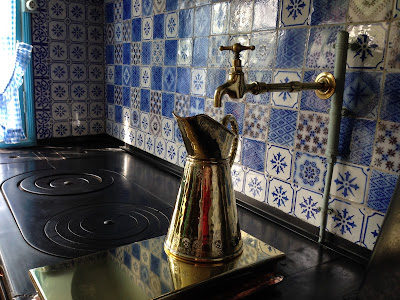Although Monet’s house and garden are the biggest and brightest
stars in the Giverny sky, when you stroll the street you’ll find other
glittering orbs in Monet’s firmament.
One spot you could walk by without noticing is Baudy’s Hotel. Notice it!
Go inside. Sit down. Practice your French to the accompanying
music of hysterical laughter, and eat like a king, or at least a well-fed duke.
You won’t be the first.
The Baudy story begins in
1886, when a group of American artists visited Giverny and stumbled into the small
grocery-café run by Angelina and Gaston Baudy.
True entrepreneurs never miss an opportunity. The Baudys not only put up the artists (whom
they described as speaking gibberish), but later added rooms, a back garden,
and enclosed studios where artists could paint in bad weather, and when
painting nudes. Certainly wish my wife
were that understanding. “Honey, I’ve
been thinking about converting the garage…you know, a quiet place where I could
take some selfies…”
Hotel Baudy added a garden
and two more studios. The hotel soon became a popular hangout, center of art,
and the go-to place for Monet’s guests.
Monet was particular about his schedule and had a keen eye for
punctuality. The story goes that he would send his car to pick up his guests (the
hotel is 5 minutes away) and take them back, just to make sure they arrived and
left on time.
And who were some of the
names of note who slept under Madame Baudy’s roof. Only the who’s who of the Impressionist
era. Paul Cézanne. The sculptor Auguste Rodin (The
Thinker). Alfred Sisley (landscapes). Pierre-Auguste Renoir. The American, Mary Cassatt.
 |
| Renoir's Winter Landscape at Giverny, 1894 |
We often think of artists as
working singularly, every canvas a product of only their own imagination. Not
so. Many of the Impressionists were
friends, and shared a profusion of ideas.
Looking from one artist’s works to another’s, you often find a symbiosis
of color, technique, style and design, filtered through their own eyes. The very best originality does not form in a
vacuum.
 |
| Alfred Sisley, Hill Path |
By the way, when was the
Impressionist era? “Please, or please
tell me,” you cry! Ok. To paint with broad strokes, which most of
the Impressionists did, I offer these slipshod dates: Born in the 1840s, died mostly around the
turn of the century, except for a few, like Monet who died in 1926.
 |
| complimentary appetizer |
 |
| Quintessentially French |
Skip forward a few years to
the spring of 2015. We were hungry and
stepped smartly into the Hotel Baudy.
Immediately we were transported into Impressionism's glory days, before the
turn of the century. You would swear
nothing has changed. Rustic. Atmospheric. A mixture of French and
gibberish floating through the air. Well, a few things have. Originally there were only two tables, now
there are many more. Also, don’t count
on getting a room. The place is now
called the L’ancien Hotel Baudy
Restaurant-Museum.
After lunch, do not forget to
stroll out back (where the toilettes are located). You’ll find an ambrosial garden, the original
studio, and a path that leads through beautiful and bountiful trees to the
studio where Cézanne painted.
 |
| Back Garden |
 |
| The first studio |
I will not describe the lunch
because the menu changes with the seasons.
But, Stevie Wonder could make your choices and you’d sing his praises
between bites. The French can teach
anyone how to eat, and how to linger just a while longer for coffee, brandy,
and conversation. For now, be content to
look at the photos and salivate…and maybe consider grabbing a palate and a few
tubes of paint. As for nude models…on
the advice of counsel, you’re on your own.
I swear I did not paint that woman!




































